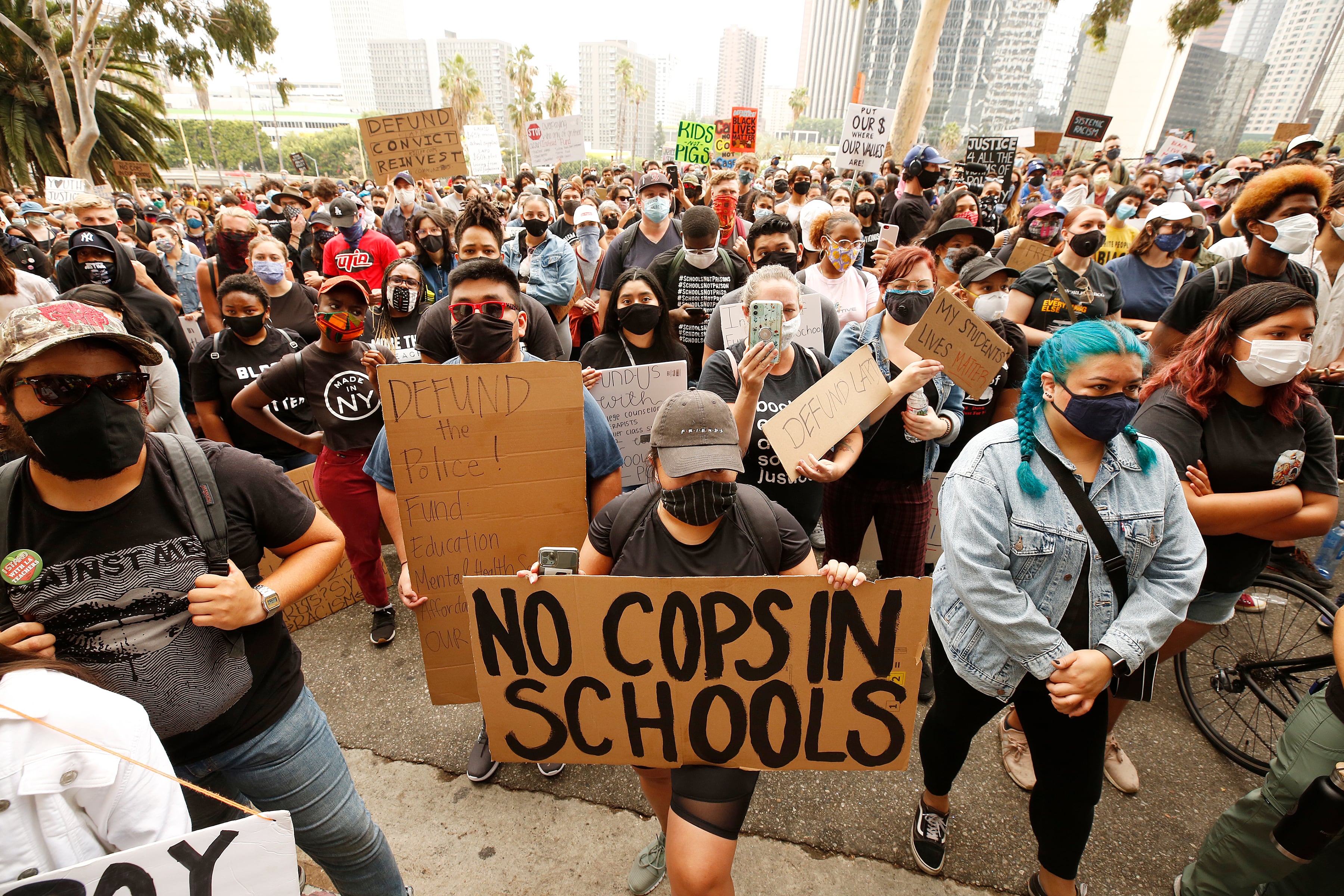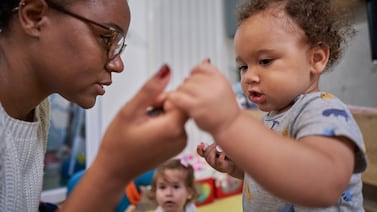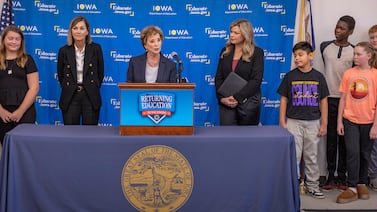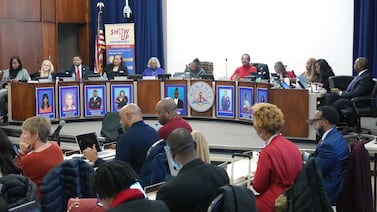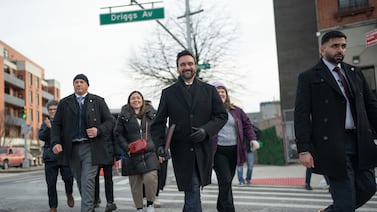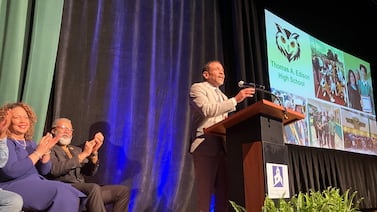School districts across the country are suddenly wrestling with the same question: Should police officers be in schools?
In the wake of George Floyd’s killing, Minneapolis schools cut their contract with the local police department. Then Portland did. Then Denver. A majority of the Oakland school board members say they will, too, while Chicago’s school board is set to vote on the issue Wednesday.
“We want to be able to have a school system where students are greeted with school nurses, with full-time mental health supports,” said Denver school board member Tay Anderson, “and not the Denver Police Department.”
Supporters of keeping police ties, including the mayors of New York City and Chicago, say that school police play an important role in maintaining order and student safety. “Unfortunately, we need security in our schools,” Chicago Mayor Lori Lightfoot said earlier this month.
Most research into these issues — whether police actually make schools safer, or whether their presence harms students — shows that schools with more police tend to have higher arrest and suspension rates. But that doesn’t tell us whether police are the cause, or if officers are just more likely to be present at schools with the biggest challenges.
A few studies have tried to nail down the effects of school police on students. They offer evidence that the presence of school police does increase suspensions and arrests, particularly for relatively young students, while providing no clear verdict on whether police reduce in-school crime or major conflict.
Meanwhile, if you ask students what they think of school police, surveys reveal generally positive views — but feelings are notably more negative among Black students, who are more likely than other students to be arrested in school.
Some research shows that more police lead to more arrests and middle-school suspensions.
Does the presence of police fuel the “school-to-prison pipeline”? A 2017 national study provides some of the clearest answers.
It found that arrest rates of children increased substantially after schools received federal grants to hire police officers, starting in 1999. Each additional officer led to about 2.5 extra in-school arrests annually of children between ages 7 and 14. There was also some evidence that additional police meant older students were more likely to be arrested both in and out of school.
This study doesn’t break down the findings by race, but numerous other analyses have shown that Black students are much more likely to be arrested in school.
A separate study found that the addition of school police officers in Texas led to a 6% increase in disciplinary actions — including suspensions — for middle school students. These suspensions were largely in response to relatively low-level offenses, and Black students were most affected. There were no clear effects on discipline rates for high school students.
These results likely reflect how school police often end up involved in regular school discipline matters, even if that isn’t formally a part of their roles.
In one recent study, researchers interviewed dozens of school personnel, including police. One officer described an incident where a student refused to leave a teacher’s classroom for an in-school suspension, and the officer was called to tell the student to leave.
“The next step after that is, if you’re refusing to do what I tell you to do,” the officer would later tell researchers, “I’m probably going to take him into custody for ‘unruly juvenile,’ and we’ll settle it that way.”
The incident, the researchers say, “illustrates the potential for school disciplinary involvement to escalate into an arrestable offense.”
One Texas study links more police to lower high school graduation rates.
There is little concrete research on the relationship between police presence and academics, but one major study recently found that police had a harmful effect.
The Texas paper showed that when middle or high schools hired more police, students were 1.7 percentage points less likely to graduate high school, compared to similar students in the same district in other years. More police also led to slightly lower college enrollment rates.
It’s not clear exactly why, and there were not clear differences by race. But other studies have found that an increased police presence, the use of aggressive search tactics, and violence outside of school can hurt students’ academic performance, particularly for Black students.
Two studies suggest that police make schools safer, but a third suggests they do not.
The previously mentioned national study showing increases in arrest rates also found evidence that school police do make schools safer, at least according to principals. School leaders reported slightly lower rates of criminal incidents — particularly violent ones — in schools with more police.
This suggests a tradeoff. “This increase in safety is not free; it is accompanied by a small increase in the probability that students who continue to engage in disruptive and harmful behavior will come into contact with the formal criminal justice system, rather than the principal’s office,” wrote researcher Emily Owens.
A separate study in West Virginia similarly found that school police led to decreases in violent crime rates. But a North Carolina paper found no evidence that grants for school police made schools safer.
What about mass shootings? A desire to prevent them or reduce their toll likely helps explain the rise of police and other security in schools. After the 2018 Parkland shooting, for instance, Florida passed a law requiring every school to have an armed guard.
There does not appear to be any research that answers this question definitively, but it’s crucial to keep in mind that incidents of mass school violence are exceedingly rare.
In other contexts, outside of school, police have been linked to lower crime rates.
Finally, these studies do not account for the possibility that police officers make schools less safe in ways that often go unrecorded. There have been high-profile instances of police officers committing violence against a student — incidents that help explain why many Black students don’t feel safer around school police officers.
Students’ perceptions of whether police officers make schools safer vary by race.
In a survey of students from a number of large California districts, 61% of white students agreed that they felt safer around the police officer at their school. Just 41% of black students said the same. Similarly, a New Orleans survey found that while 77% of white students felt safer around school security guards, just 54% of black students did.
New York City’s most recent school system-wide survey found that 81% of students said school police officers helped keep schools safe and respectful. This figure was somewhat lower among students in predominantly Black schools, where 76% of students agreed, according to a Chalkbeat analysis.
These results track disparities in adult perception of police, where race again plays a key role.
A recent study found that police in predominantly Black schools were more likely to view students in those schools as a threat. “These findings help explain how SROs’ perceptions might expose students of color to more frequent and intense police interactions,” the researchers concluded.

